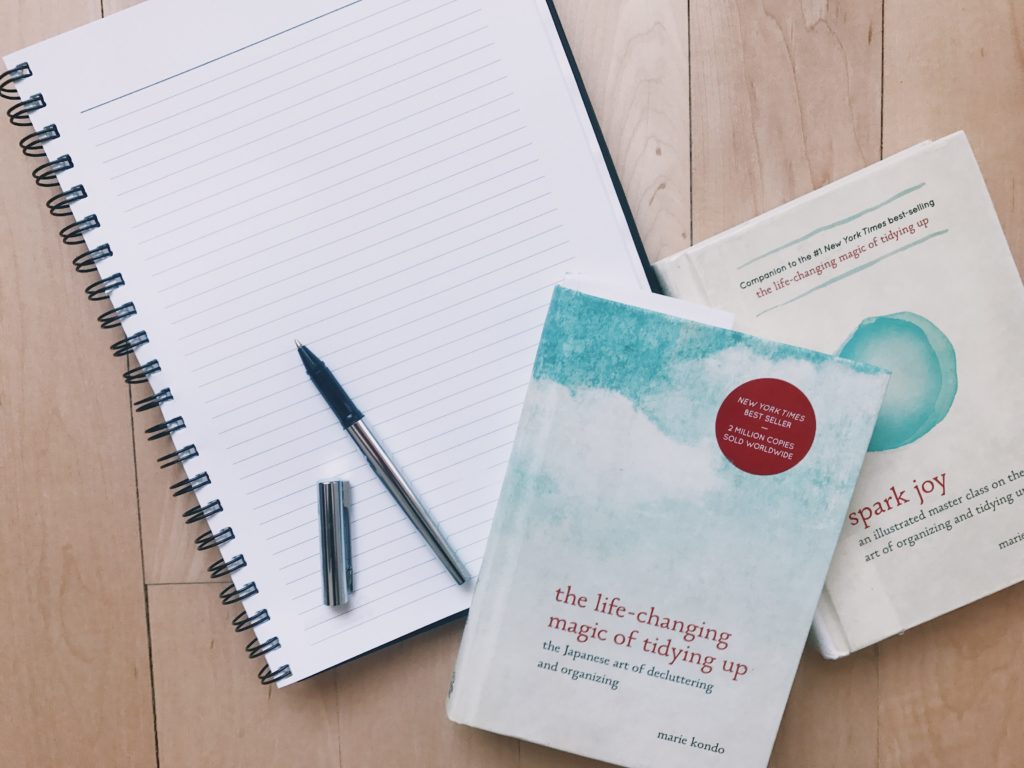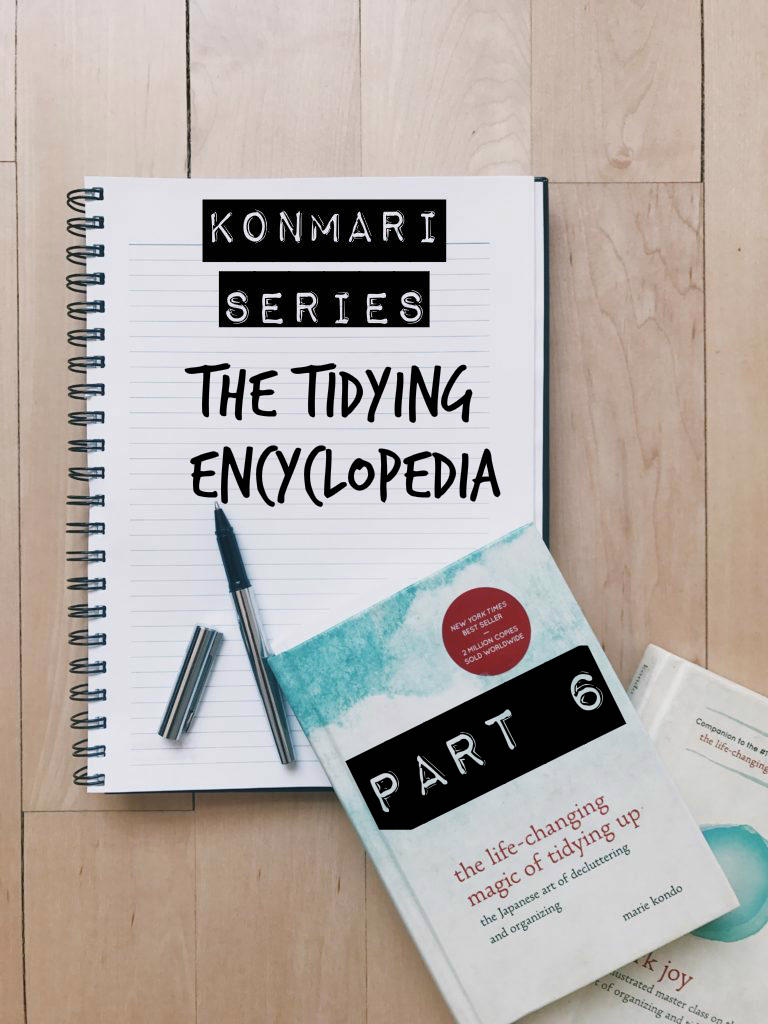This post is part of the KonMari Series in which I document my journey to becoming a certified KonMari organizing consultant. Start from the beginning here and/or see all posts of the series here.
Today, I share my notes of part of Marie Kondo’s second book “Spark Joy.” I’m dividing my writing about this book into two posts. In today’s (second) post (find the first one here), I go over the tidying encyclopedia and end with a few remarks on Kondo’s proposed “life-changing magic”.
Please note that this should not serve as a complete summary of the book. However, it is merely a roundup of points that stood out to me and that I found important. I also add my personal reflections to some aspects.
The Tidying Encyclopedia
The core of “Spark Joy” consists of a complete tidying encyclopedia in which Kondo provides more detailed instructions on how to go about tidying the different categories and sub-categories. There are also many illustrations showing how to fold and store certain items.
Clothes
The recommended order for tidying clothes is
- Tops
- Bottoms
- Dresses/skirts
- Clothes that need to be hung
- Socks/stockings
- Underwear
- Bags
- Accessories (e.g., scarves, belts, hats)
- Shoes
When folding long-sleeved items, you should avoid having the sleeves overlap each other since this would result in unnecessary bulk. Thus, you should fold the sleeves down the middle (after folding in the left and right side to the middle).
Items that are made out of very thin or flimsy material would not stand up after folding them. Rather, you can roll them up after the step of folding them in half lengthwise. Also, the other clothing items in your drawer will give them support to stand up as rolls (bento box concept).
Bulky items, such as heavy-knit sweaters, are ok to be laid down because they wouldn’t stand up on their own. Alternatively, you could put them in cloth bags (if they’re off-season) and remove the air as much as possible in order to make them less bulky.
In general, you should hang dresses and skirts. Especially, if they have embellishments or draping that makes them difficult to fold. However, you can also fold them if you want or if there’s not enough space for hanging clothing.
You should fold socks and thicker tights. On the other hand, you should roll stockings since they’re made out of thin material.
Underwear should be folded or rolled depending on the material. Then, Kondo suggests placing them in tissue boxes. I’m not sure exactly what kind of boxes she’s referring to here. But I used the lids of shoeboxes, which worked just fine.
Also, you should create a color gradation with lighter colors in the front and darker colors in the back of your drawers. The same applies to the hanging clothes as well (aim to hang dark and heavy items on the left, rising up to the right with brighter and lighter clothes).
Shoes can be stored on a shelf or at the bottom of the closet out in the open. Heavier shoes go on the bottom and lighter shoes on the top. If you have space issues, you can also store them in shoeboxes (even two pairs in one box if necessary).
Packing A Suitcase
If you have to pack a suitcase, you can basically apply the same principles. Fold your clothes and stand them upright. Fold suits and/or bras on top. Place underwear and other smaller items in small travel bags or pouches. Also, you should transfer liquids into smaller containers or jars in order to avoid wasting space.
Books
Kondo recommends discarding of all books you haven’t started reading yet and those you’ve started but never finished. She claims that if you only keep the books you love, the quality of the information you obtain will change for the better.
You’ll soon see that the information you need comes just when you need it, and when it does, you’ll find that you respond to it immediately in a new pattern of behavior that wasn’t possible when you were hoarding books and neglecting the information they contained.
I think that she’s right on here. Personally, I often find myself drowning in information and surrounding myself with articles and books I’m telling myself I need to read. I live in constant FOMO (“fear of missing out”) information-wise. Oftentimes the vast amount of information I gather prevents me from actually taking action in a timely manner.There’s no way of knowing everything there’s to know about a subject. There’s just no way. Thus, making a clean slate in this regard is healthy for people like me. Because if there truly is something you need to know, you can always seek it out and you’ll act right on it (i.e., read the information immediately), instead of having it lying around, waiting to be consumed by you, which will never happen if you’re being honest.
There’s no way of knowing everything there’s to know about a subject. There’s just no way. Thus, making a clean slate in this regard is healthy for people like me. Because if there truly is something you need to know, you can always seek it out and you’ll act right on it (i.e., read the information immediately), instead of having it lying around, waiting to be consumed by you, which will never happen if you’re being honest.
Papers
As mentioned in her previous book, Kondo says that you should only keep papers of the following three categories:
- Papers that are currently in use (deal with them asap).
- Papers that need to be stored for a limited period of time.
- Papers that need to be stored indefinitely.
In general, you should discard greeting cards. Except for those that truly spark joy for you.
Komono
Komono is the most difficult category because it consists of the most sub-categories. Kondo suggests the following:
- CDs and DVDs
- Stationery supplies
- Electrical items
- Skincare products and cosmetics
- Relaxation goods
- Medicines
- Valuables
- Sewing kits
- Tools
- Hobby items
- Collectibles
- Things you kept “just because”
- Linen and bedding
- Towels
- Stuffed toys
- Recreational items
- Seasonal items
- Emergency supplies
- Rain gear
- Kitchen komono
- Cleaning supplies
- Laundry supplies
- Bathroom komono
You can create additional komono sub-categories if you need to. The order in which you tackle them is up to you. Also, when you get to put away the things you keep, store everything upright as best as possible. It helps you to see everything you have at once. It also helps you easily retrieve items you need.
In the following paragraphs, I highlight only certain points about a few of the above-mentioned sub-categories. Again, the book is literally an encyclopedia, and thus it wouldn’t make sense to aim for a complete summary.
According to Kondo, many people start with CDs and DVDs. If you plan on transferring the contents onto your computer, you can put them in the same box with the papers that are currently in use and need to be dealt with. When it comes to sentimental CDs of friends or former lovers, she recommends discarding if the memory is what’s important to you (and not the actual songs). And by all means, don’t stop in your tidying flow to listen to any of the CDs!
Kondo recommends storing skincare products/cosmetics and make-up items away from each other. It makes sense because items from the one category have a potential to ruin items from the other category if they get in contact with each other. This is due to their different natures of mostly dry (make-up) and liquid (skincare).
Depending on how much make-up you own, you can apply different approaches to storing. One way would be to keep the items that belong together in one spot. For example, keep items you use on a daily basis in one spot and lesser-used ones in a separate spot. If you have a lot of stuff, it can come in handy to store individual components separately in compartmentalized boxes etc. If you don’t have a lot of make-up, Kondo recommends separating between items that can stand up (put in can or glass) and items that lay down (put in box or pouch).
Kondo spends a huge portion of the komono chapter writing about kitchen komono. Granted, many items you own probably belong in this category (if you have a kitchen space). These can be further divided into roughly three categories:
- Eating implements
- Cooking tools
- Food
Very important here is that the criterion for storage is ease of cleaning (and NOT ease of use). She came to this realization after observing processes in several restaurant kitchens. Basically, what that means is that you should keep your counters clear. Thus, you should place all your kitchen items in cupboards as much as possible. Kondo also wants you to keep the dish soap and sponge away from the sink (in the cupboard under the sink). Unless, and that applies to me personally, you use the soap and sponge all the time.
Sentimental Items (Mementos)
As always, you should stick to the basic tidying principle and only keep items that spark joy for you. If you have too many items and you struggle with deciding what to keep, Kondo recommends coming up with a limit. For instance, you may want to limit yourself to only keeping a certain number of your kids’ art creations.
Life-Changing Magic
Kondo is certain about one thing. She’s convinced that tidying will change your life. She has seen changes in her clients in these areas:
- Social life
- Relationship with themselves
- Gain of confidence
- Positive outlook into future
- Starting to meet different people
- Starting to enjoy life more
- Love life gets put in order
Our relationships with other people are reflected in our relationships with things, and likewise, our relationships with things show up in our relationships with people.
Kondo wants you to “be like the sun” if the stuff/hoarding of other family members bothers you. Here, she refers to Aesop’s fable “The North Wind And The Sun”,:
The North Wind and the Sun disputed as to which was the most powerful, and agreed that he should be declared the victor who could first strip a wayfaring man of his clothes. The North Wind first tried his power and blew with all his might, but the keener his blasts, the closer the Traveler wrapped his cloak around him, until at last, resigning all hope of victory, the Wind called upon the Sun to see what he could do. The Sun suddenly shone out with all his warmth. The Traveler no sooner felt his genial rays than he took off one garment after another, and at last, fairly overcome with heat, undressed and bathed in a stream that lay in his path.
Persuasion is better than force.
It doesn’t make sense to force other family members to tidy up. It doesn’t help the cause and might even cause a backlash. On the contrary, just do your part and eventually, your other family members will follow as they get to see the positive impact it had on you. In the meantime, try to make peace with the things that bother you. Try to face those things with an open mind and accept them.
I realized that when I start judging others, it’s usually because something in my own life needs to be put in order.
At last, if you’re feeling overwhelmed by the vast information and rules shared in her book “Spark Joy”, Kondo has one last advice: don’t freak out! Just follow the basics, make exceptions to the rules as you need to and move on. Have fun and enjoy the tidying process!
——-
In the next part of the KonMari series, I will update you on my own tidying process as well as the registration and requirements for the seminar in Los Angeles.
PIN IT:


